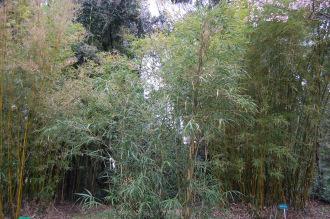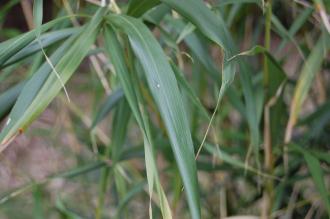
Pleioblastus linearis (04/04/2015, Kyoto Botanic Gardens, Kyoto, Japan)
Position: Full sun to partial shade
Flowering period: N/A
Soil: Moist, well drained
Eventual Height: 4m
Eventual Spread: 2m
Hardiness: 7b, 8a, 8b, 9a, 9b, 10a, 10b, 11
Family: Poaceae
Pleioblastus linearis is an evergreen bamboo with a spreading habit and erect canes. Its mid green leaves are lanceolate with entire margins, up to 25cm long and 15mm broad. Its mid green canes may achieve diameter of up to 1.5cm. Its roots are rhizomes which aids its spread and given the right conditions may become invasive.

Pleioblastus linearis Leaf (04/04/2015, Kyoto Botanic Gardens, Kyoto, Japan)
Pleioblastus linearis, commonly known as Pleioblastus, is native to south Japan. Pleioblastus linearis is synonymous with Arundinaria linearis.
The etymological root of the binomial name Pleioblastus is derived from the Greek pleios meaning ‘many’ and blastos meaning ‘shoot’. Linearis is from the Latin lineare meaning ‘to line’.
The landscape architect may find Pleioblastus linearis useful as a screening or hedging bamboo as its canes have a dense habit.
Ecologically, Pleioblastus linearis is of little wildlife value in the UK.

Pleioblastus linearis Cane (04/04/2015, Kyoto Botanic Gardens, Kyoto, Japan)
Pleioblastus linearis prefers moist, fertile, humus rich, well-drained soils. It tolerates most pH of soil.
Pleioblastus linearis requires little maintenance. Large clumps may be divided in spring. A root barrier may be installed at the time of planting to restrict the spread of this plant.


